EAPP Outlining in reading texts discipline
Download as pptx, pdf0 likes71 views
This lesson outlines how to effectively write a summary by identifying and distilling key ideas from a text. It emphasizes the importance of previewing and skimming techniques to prepare for summarization, allowing for better focus on essential information. The goals are to reproduce the main concepts and express them clearly in a concise manner.
1 of 16
Download to read offline
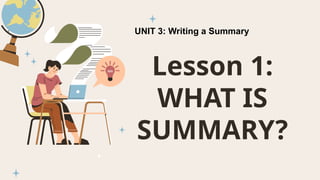


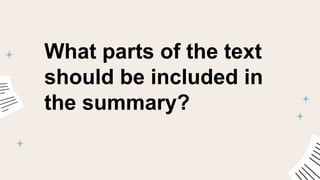
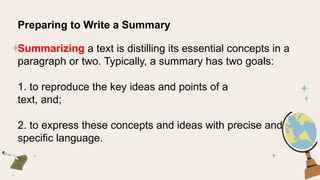
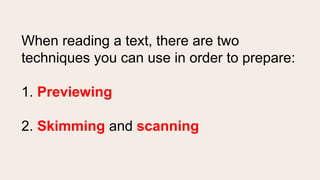
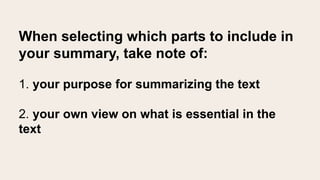
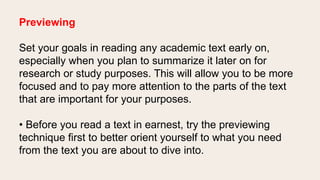
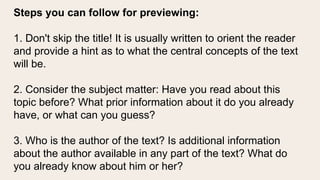
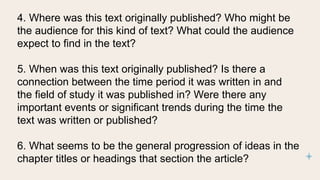


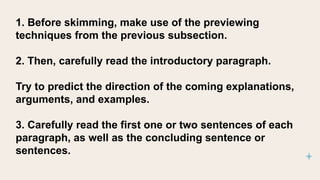



Ad
Recommended
Advice on academic writing
Advice on academic writingMaruCarretero
╠²
The document provides advice on academic writing. It discusses the key characteristics of academic writing, including being formal, unbiased, clear, precise, well-structured, and well-sourced. It contrasts academic writing styles with high school writing. The document also outlines the steps for effective reading, research, planning, organizing, using sources, and creating bibliographies for academic writing. This includes techniques like previewing, skimming, scanning, summarizing, using topic sentences and outlines to structure paragraphs and essays, properly citing sources to avoid plagiarism, and formatting bibliographies.R&W-LESSON 3 (READING TEXT)power point presentation
R&W-LESSON 3 (READING TEXT)power point presentationDaisyCabuagPalaruan
╠²
The document discusses reading and writing skills, highlighting the cognitive processes involved in reading, such as decoding symbols and making meaning from text. It emphasizes the importance of pre-reading, reading, and post-reading strategies to enhance comprehension and retention. Techniques such as skimming and scanning, along with summarization, are recommended to improve reading effectiveness.Bahan Ajar Aplikasi Bahasa Inggris Tahun 2014
Bahan Ajar Aplikasi Bahasa Inggris Tahun 2014virmannsyah
╠²
This document outlines a course on English language application focusing on reading techniques and translation skills. It emphasizes the importance of prereading for improved comprehension and introduces strategies such as making predictions and connections to prior knowledge. Additionally, it discusses essential skills needed for understanding English texts effectively.Entry 3
Entry 3AgostinaSanguinetti
╠²
The document provides guidance on various aspects of academic writing such as essay writing, dealing with writer's block, organizing essays, reading and researching, taking notes, using sources, and specific writing tasks. It discusses developing a clear argument and thesis in essays. It offers tips for planning and outlining essays while avoiding overplanning. The document also covers summarizing, paraphrasing, using quotations, and documenting sources properly. Various writing challenges are addressed, along with punctuation, grammar, and style concerns.Reading skills notes
Reading skills notesTsholofelo Otimile
╠²
University students are expected to do a significant amount of reading for various purposes like lectures, tutorials, assignments, tests and exams. Effective academic reading requires a strategic approach where students actively engage with the text by asking questions and taking a critical approach. Some tips for active reading include previewing texts to get an overview, scanning to find specific information, skimming to get a general impression, and intensive reading to understand complex concepts. It is important for students to be selective in their reading by focusing on required readings and identifying essential information related to their purpose and assignment questions. Strategic reading techniques like setting goals, breaking reading into manageable segments, and keeping track of references can help students make the most of their limited time.Reading Skills (PDF)
Reading Skills (PDF)PiLNAfrica
╠²
This document provides an introduction to reading skills, emphasizing the importance of effective reading strategies such as skimming, scanning, and active reading for comprehension. It outlines methods like SQ3R for understanding written information, alongside common obstacles to effective reading. Additionally, various reading techniques are discussed, including focused reading, extensive reading, and intensive reading, aiming to enhance student engagement and comprehension.Reading Skills
Reading SkillsSaide OER Africa
╠²
This document serves as an introduction to effective reading strategies, highlighting the importance of reading as an active process for comprehension and learning. It presents various techniques such as skimming, scanning, and the SQ3R method, aiming to enhance students' reading skills and critical engagement with texts. Additionally, it discusses barriers to effective reading and emphasizes the necessity of adapting reading strategies to individual learning styles.1 Reading Skills Pp D Ul
1 Reading Skills Pp D UlBayarmaa GBayarmaa
╠²
This document provides tips for improving reading skills at the university level. It discusses three styles of reading: scanning for specific information, skimming to get the gist, and detailed reading. It recommends active reading techniques like underlining, highlighting, noting keywords and questions. It also describes the SQ3R technique for efficient reading: survey, question, read, recall and review. Finally, it notes the importance of recognizing authors' structural cues and expanding one's vocabulary.KNC-201 Unit-I Part-2aaaaaaaaaaaaaaa.pptx
KNC-201 Unit-I Part-2aaaaaaaaaaaaaaa.pptxankit2125cse1109
╠²
The document outlines effective reading and writing strategies within the context of academic skills, emphasizing the importance of active engagement with texts and the use of structured writing to convey ideas clearly. It discusses various reading techniques, including skimming, scanning, and critical reading, along with writing methods such as deductive, inductive, and expository styles. Additionally, it highlights key components of academic writing, including clarity, conciseness, and the necessity of supporting arguments with evidence.Essay Writing Simplified Secret Effective Shortcuts
Essay Writing Simplified Secret Effective ShortcutsEssayWriter.Co.Uk
╠²
The document outlines a simplified approach to essay writing in five essential steps: setting a clear goal, conducting research and note-taking, organizing notes to develop a thesis, writing freely without immediate concern for coherence, and finalizing the essay with a structured outline. It emphasizes the importance of starting promptly, focusing on important points during research, and avoiding the urge to edit prematurely. The final essay should include an introduction with a thesis statement, structured main points, and a conclusion that reiterates the main argument.Summarizing a text.pptxegerhtrjryhwegveswg
Summarizing a text.pptxegerhtrjryhwegveswgChristineDragonLlant
╠²
The document outlines effective strategies for summarizing texts, emphasizing the importance of understanding central ideas, using one's own wording, and avoiding personal opinions. It describes various text structures, such as classification and problem-solution, to help guide summarization. Additionally, it suggests practical steps like identifying key details and using signal words for developing concise summaries.Advice on academic writing
Advice on academic writingRamiro Rodr├Łguez
╠²
The document provides advice to students on academic writing at the university level. It discusses developing an argument with a clear thesis, structuring essays with topic sentences and well-organized paragraphs. General writing tips include starting early, extensive revision, and proofreading. When researching, the document advises taking detailed notes and using sources critically to form your own analysis. It also reviews techniques like skimming, scanning, and summarizing to aid comprehension of academic texts.Academic Writing Advice
Academic Writing AdviceALEX CARSON
╠²
This document provides advice on academic writing, including how to structure essays and paragraphs. It recommends that essays have a clear argument and thesis. Paragraph structure should include a topic sentence that presents the central idea. When taking notes from research, students should focus on key ideas and avoid copying large portions of text. Summarizing requires distilling the main concepts into a concise overview using your own words. Previewing a text helps orient the reader to what is most important.How to write a summary
How to write a summaryArmando Castillo
╠²
This document outlines an 8-step method for writing a concise summary. The steps include: 1) dividing the text into sections,
2) reading the text straight through, 3) re-reading and underlining key facts, 4) writing one sentence to capture the main idea
of each section, 5) writing a thesis statement that communicates the overall purpose, 6) using the thesis as an introduction
and sentences as the body, with transitions, 7) checking for accuracy, and 8) revising for style and flow. Following these
steps will allow the writer to effectively summarize texts for any class or subject.COT 4 21st century reading style. .pdf
COT 4 21st century reading style. .pdfAlleahGevero1
╠²
The document outlines various reading styles that students should learn, including skimming, scanning, intensive, and extensive reading, along with their significance in understanding texts. It emphasizes the importance of reading comprehension as a skill that enhances critical thinking, vocabulary, and overall communication. Additionally, it discusses the concept of critical reading, which involves actively engaging with a text to analyze and interpret its meaning rather than passively accepting it.Learning Skills 2 Reading For Information ║▌║▌▀Żs
Learning Skills 2 Reading For Information ║▌║▌▀ŻsRuzita Ramly
╠²
This document discusses different reading techniques for fast and slow reading. It describes scanning and skimming as techniques for fast reading to gain an overview or locate specific information. Slow reading techniques include analytical and critical approaches to understand, evaluate, and remember information read. The SQ3R method is presented as an active approach for slow reading academic material, involving surveying, questioning, reading, reciting, and reviewing the content.Scaffolding Summary Writing
Scaffolding Summary WritingLorenKnights
╠²
The document outlines the importance of summary writing as a complex academic skill that students need to be explicitly taught. A good summary is concise, coherent, and focuses on the main ideas while excluding minor details. It emphasizes techniques for identifying key points, improving reading and critical thinking skills, and structuring a summary effectively.Comprehension Skills
Comprehension SkillsHanshal Nautiyal
╠²
The document outlines comprehension skills, emphasizing methods such as SQ3R and SQ4R for improving reading and understanding of texts. It also discusses paraphrasing, summarizing, pr├®cis writing, and the importance of listening comprehension in communication. Each method and concept is elaborated on to enhance the reader's ability to engage with and retain information from various types of materials.Power point for Reading Comprehension topic grade 8.pptx
Power point for Reading Comprehension topic grade 8.pptxMaHopeJahleenFiedaca1
╠²
The document discusses various reading comprehension techniques including scanning, skimming, speed reading, and intensive reading, each serving distinct purposes in processing information. It categorizes text typesŌĆöexpository, descriptive, persuasive, and narrativeŌĆöbased on their main objectives and outlines the author's purposes such as to persuade, inform, entertain, or express feelings. Techniques for improving reading skills, particularly speed and comprehension, are also emphasized.academic writing
academic writingAnita Dorre
╠²
This document provides advice on various aspects of academic writing such as essay structure, research, and reading strategies. It recommends that essays have a clear argument, answer a question or thesis, and be logically organized to present the argument. Effective planning is important to produce a coherent paper. Strong introductions set up the topic and context while conclusions provide closure and further thought. Paragraphs should each focus on a central idea supported by topic sentences. Thorough research requires critical reading, note-taking, and evaluating sources. Previewing, skimming, and summarizing texts aid comprehension.SQ3R.pptx SQ3R.pptx SQ3R.pptx SQ3R.pptx SQ3R.pptx
SQ3R.pptx SQ3R.pptx SQ3R.pptx SQ3R.pptx SQ3R.pptxLlemorSoledSeyer1
╠²
The document discusses various reading techniques such as skimming and scanning to effectively absorb and recall information from texts. It provides strategies for quickly identifying main ideas, keywords, and relevant details, while emphasizing the importance of formulating questions before reading and actively recalling the content afterward. Additionally, it encourages reviewing notes to solidify understanding and retention of the material.LEE IV
LEE IVluzfernndez9
╠²
This document provides advice on various aspects of academic essay writing such as planning, organizing, developing a thesis, writing introductions and conclusions, structuring paragraphs, taking notes, reading critically, dealing with new vocabulary, and summarizing. It discusses establishing a clear argument, creating an outline, introducing context, conveying closing thoughts, using topic sentences and cohesive devices, labeling notes, evaluating evidence, and avoiding plagiarism when incorporating sources. The document also briefly outlines specific types of academic writing like abstracts, comparative essays, and annotated bibliographies.Week 2 - reading and note taking skills bb
Week 2 - reading and note taking skills bbNathaliaGuimares15
╠²
This document provides strategies for effective reading, note-taking, and becoming a critical reader at the university level. It recommends skimming texts first to get an overview before reading selectively. When taking notes, use bullet points and abbreviations rather than full sentences. Be a critical reader by questioning claims and looking for biases or disagreeing viewpoints. Read introductions and conclusions first to understand the main argument and thesis. Take notes on topic sentences to grasp each paragraph's essential point.Reading
ReadingBayarmaa GBayarmaa
╠²
The document discusses various aspects of reading, including what reading is, typical reading rates for different purposes, and strategies for effective reading. It defines reading as deriving meaning from text and discusses decoding skills, vocabulary knowledge, and activating prior knowledge in comprehension. Reading rates discussed are 100-200 words per minute for learning, 200-400 wpm for comprehension, and 400-700 wpm for skimming. The document provides advice on choosing an appropriate reading rate and strategies like previewing, reading for meaning, using context, making inferences, summarizing, taking notes, paraphrasing, and applying academic skills.Lee iv presentation
Lee iv presentationluzfernndez9
╠²
This document provides advice on various aspects of academic essay writing such as planning, organizing, developing a thesis, writing introductions and conclusions, structuring paragraphs, taking notes, reading critically, dealing with new vocabulary, and avoiding plagiarism. It discusses formatting different types of academic writing like abstracts, comparative essays, and annotated bibliographies. Tips are provided on revising, editing, punctuation, and proper use of the English language. Specific techniques are outlined for previewing, skimming, scanning and summarizing texts.Lee iv presentation
Lee iv presentationluzfernndez9
╠²
This document provides advice on various aspects of academic essay writing such as planning, organizing, developing a thesis, writing introductions and conclusions, structuring paragraphs, taking notes, reading critically, dealing with new vocabulary, and summarizing. It discusses establishing a clear argument, creating an outline, introducing topics and concluding thoughts. The document also covers specific types of academic writing like abstracts, comparative essays, and annotated bibliographies. Overall, the document offers guidance on the process of researching, writing, and structuring different components of academic essays.Summary Writing
Summary WritingRyanEstonio
╠²
This document provides guidance on writing summaries. It defines a summary as a shortened version of the original text that retains the essential information. A good summary is brief, understandable without referring to the original, and contains only the ideas from the original. The document recommends techniques for writing summaries, such as paraphrasing using one's own words, finding the topic sentence, and making an outline. It outlines the steps to write a summary, including reading the original text multiple times, taking notes, formulating a thesis statement, and editing the draft.Personal Development about Thinking and Emotions
Personal Development about Thinking and Emotionsadeborja
╠²
Understanding the Intensity and Differentiation of EmotionsMore Related Content
Similar to EAPP Outlining in reading texts discipline (20)
1 Reading Skills Pp D Ul
1 Reading Skills Pp D UlBayarmaa GBayarmaa
╠²
This document provides tips for improving reading skills at the university level. It discusses three styles of reading: scanning for specific information, skimming to get the gist, and detailed reading. It recommends active reading techniques like underlining, highlighting, noting keywords and questions. It also describes the SQ3R technique for efficient reading: survey, question, read, recall and review. Finally, it notes the importance of recognizing authors' structural cues and expanding one's vocabulary.KNC-201 Unit-I Part-2aaaaaaaaaaaaaaa.pptx
KNC-201 Unit-I Part-2aaaaaaaaaaaaaaa.pptxankit2125cse1109
╠²
The document outlines effective reading and writing strategies within the context of academic skills, emphasizing the importance of active engagement with texts and the use of structured writing to convey ideas clearly. It discusses various reading techniques, including skimming, scanning, and critical reading, along with writing methods such as deductive, inductive, and expository styles. Additionally, it highlights key components of academic writing, including clarity, conciseness, and the necessity of supporting arguments with evidence.Essay Writing Simplified Secret Effective Shortcuts
Essay Writing Simplified Secret Effective ShortcutsEssayWriter.Co.Uk
╠²
The document outlines a simplified approach to essay writing in five essential steps: setting a clear goal, conducting research and note-taking, organizing notes to develop a thesis, writing freely without immediate concern for coherence, and finalizing the essay with a structured outline. It emphasizes the importance of starting promptly, focusing on important points during research, and avoiding the urge to edit prematurely. The final essay should include an introduction with a thesis statement, structured main points, and a conclusion that reiterates the main argument.Summarizing a text.pptxegerhtrjryhwegveswg
Summarizing a text.pptxegerhtrjryhwegveswgChristineDragonLlant
╠²
The document outlines effective strategies for summarizing texts, emphasizing the importance of understanding central ideas, using one's own wording, and avoiding personal opinions. It describes various text structures, such as classification and problem-solution, to help guide summarization. Additionally, it suggests practical steps like identifying key details and using signal words for developing concise summaries.Advice on academic writing
Advice on academic writingRamiro Rodr├Łguez
╠²
The document provides advice to students on academic writing at the university level. It discusses developing an argument with a clear thesis, structuring essays with topic sentences and well-organized paragraphs. General writing tips include starting early, extensive revision, and proofreading. When researching, the document advises taking detailed notes and using sources critically to form your own analysis. It also reviews techniques like skimming, scanning, and summarizing to aid comprehension of academic texts.Academic Writing Advice
Academic Writing AdviceALEX CARSON
╠²
This document provides advice on academic writing, including how to structure essays and paragraphs. It recommends that essays have a clear argument and thesis. Paragraph structure should include a topic sentence that presents the central idea. When taking notes from research, students should focus on key ideas and avoid copying large portions of text. Summarizing requires distilling the main concepts into a concise overview using your own words. Previewing a text helps orient the reader to what is most important.How to write a summary
How to write a summaryArmando Castillo
╠²
This document outlines an 8-step method for writing a concise summary. The steps include: 1) dividing the text into sections,
2) reading the text straight through, 3) re-reading and underlining key facts, 4) writing one sentence to capture the main idea
of each section, 5) writing a thesis statement that communicates the overall purpose, 6) using the thesis as an introduction
and sentences as the body, with transitions, 7) checking for accuracy, and 8) revising for style and flow. Following these
steps will allow the writer to effectively summarize texts for any class or subject.COT 4 21st century reading style. .pdf
COT 4 21st century reading style. .pdfAlleahGevero1
╠²
The document outlines various reading styles that students should learn, including skimming, scanning, intensive, and extensive reading, along with their significance in understanding texts. It emphasizes the importance of reading comprehension as a skill that enhances critical thinking, vocabulary, and overall communication. Additionally, it discusses the concept of critical reading, which involves actively engaging with a text to analyze and interpret its meaning rather than passively accepting it.Learning Skills 2 Reading For Information ║▌║▌▀Żs
Learning Skills 2 Reading For Information ║▌║▌▀ŻsRuzita Ramly
╠²
This document discusses different reading techniques for fast and slow reading. It describes scanning and skimming as techniques for fast reading to gain an overview or locate specific information. Slow reading techniques include analytical and critical approaches to understand, evaluate, and remember information read. The SQ3R method is presented as an active approach for slow reading academic material, involving surveying, questioning, reading, reciting, and reviewing the content.Scaffolding Summary Writing
Scaffolding Summary WritingLorenKnights
╠²
The document outlines the importance of summary writing as a complex academic skill that students need to be explicitly taught. A good summary is concise, coherent, and focuses on the main ideas while excluding minor details. It emphasizes techniques for identifying key points, improving reading and critical thinking skills, and structuring a summary effectively.Comprehension Skills
Comprehension SkillsHanshal Nautiyal
╠²
The document outlines comprehension skills, emphasizing methods such as SQ3R and SQ4R for improving reading and understanding of texts. It also discusses paraphrasing, summarizing, pr├®cis writing, and the importance of listening comprehension in communication. Each method and concept is elaborated on to enhance the reader's ability to engage with and retain information from various types of materials.Power point for Reading Comprehension topic grade 8.pptx
Power point for Reading Comprehension topic grade 8.pptxMaHopeJahleenFiedaca1
╠²
The document discusses various reading comprehension techniques including scanning, skimming, speed reading, and intensive reading, each serving distinct purposes in processing information. It categorizes text typesŌĆöexpository, descriptive, persuasive, and narrativeŌĆöbased on their main objectives and outlines the author's purposes such as to persuade, inform, entertain, or express feelings. Techniques for improving reading skills, particularly speed and comprehension, are also emphasized.academic writing
academic writingAnita Dorre
╠²
This document provides advice on various aspects of academic writing such as essay structure, research, and reading strategies. It recommends that essays have a clear argument, answer a question or thesis, and be logically organized to present the argument. Effective planning is important to produce a coherent paper. Strong introductions set up the topic and context while conclusions provide closure and further thought. Paragraphs should each focus on a central idea supported by topic sentences. Thorough research requires critical reading, note-taking, and evaluating sources. Previewing, skimming, and summarizing texts aid comprehension.SQ3R.pptx SQ3R.pptx SQ3R.pptx SQ3R.pptx SQ3R.pptx
SQ3R.pptx SQ3R.pptx SQ3R.pptx SQ3R.pptx SQ3R.pptxLlemorSoledSeyer1
╠²
The document discusses various reading techniques such as skimming and scanning to effectively absorb and recall information from texts. It provides strategies for quickly identifying main ideas, keywords, and relevant details, while emphasizing the importance of formulating questions before reading and actively recalling the content afterward. Additionally, it encourages reviewing notes to solidify understanding and retention of the material.LEE IV
LEE IVluzfernndez9
╠²
This document provides advice on various aspects of academic essay writing such as planning, organizing, developing a thesis, writing introductions and conclusions, structuring paragraphs, taking notes, reading critically, dealing with new vocabulary, and summarizing. It discusses establishing a clear argument, creating an outline, introducing context, conveying closing thoughts, using topic sentences and cohesive devices, labeling notes, evaluating evidence, and avoiding plagiarism when incorporating sources. The document also briefly outlines specific types of academic writing like abstracts, comparative essays, and annotated bibliographies.Week 2 - reading and note taking skills bb
Week 2 - reading and note taking skills bbNathaliaGuimares15
╠²
This document provides strategies for effective reading, note-taking, and becoming a critical reader at the university level. It recommends skimming texts first to get an overview before reading selectively. When taking notes, use bullet points and abbreviations rather than full sentences. Be a critical reader by questioning claims and looking for biases or disagreeing viewpoints. Read introductions and conclusions first to understand the main argument and thesis. Take notes on topic sentences to grasp each paragraph's essential point.Reading
ReadingBayarmaa GBayarmaa
╠²
The document discusses various aspects of reading, including what reading is, typical reading rates for different purposes, and strategies for effective reading. It defines reading as deriving meaning from text and discusses decoding skills, vocabulary knowledge, and activating prior knowledge in comprehension. Reading rates discussed are 100-200 words per minute for learning, 200-400 wpm for comprehension, and 400-700 wpm for skimming. The document provides advice on choosing an appropriate reading rate and strategies like previewing, reading for meaning, using context, making inferences, summarizing, taking notes, paraphrasing, and applying academic skills.Lee iv presentation
Lee iv presentationluzfernndez9
╠²
This document provides advice on various aspects of academic essay writing such as planning, organizing, developing a thesis, writing introductions and conclusions, structuring paragraphs, taking notes, reading critically, dealing with new vocabulary, and avoiding plagiarism. It discusses formatting different types of academic writing like abstracts, comparative essays, and annotated bibliographies. Tips are provided on revising, editing, punctuation, and proper use of the English language. Specific techniques are outlined for previewing, skimming, scanning and summarizing texts.Lee iv presentation
Lee iv presentationluzfernndez9
╠²
This document provides advice on various aspects of academic essay writing such as planning, organizing, developing a thesis, writing introductions and conclusions, structuring paragraphs, taking notes, reading critically, dealing with new vocabulary, and summarizing. It discusses establishing a clear argument, creating an outline, introducing topics and concluding thoughts. The document also covers specific types of academic writing like abstracts, comparative essays, and annotated bibliographies. Overall, the document offers guidance on the process of researching, writing, and structuring different components of academic essays.Summary Writing
Summary WritingRyanEstonio
╠²
This document provides guidance on writing summaries. It defines a summary as a shortened version of the original text that retains the essential information. A good summary is brief, understandable without referring to the original, and contains only the ideas from the original. The document recommends techniques for writing summaries, such as paraphrasing using one's own words, finding the topic sentence, and making an outline. It outlines the steps to write a summary, including reading the original text multiple times, taking notes, formulating a thesis statement, and editing the draft.Recently uploaded (12)
Personal Development about Thinking and Emotions
Personal Development about Thinking and Emotionsadeborja
╠²
Understanding the Intensity and Differentiation of EmotionsMap Reading & Where to Get Free Maps and Apps.pptx
Map Reading & Where to Get Free Maps and Apps.pptxBob Mayer
╠²
Most of us rely on GPS, whether in our car or via our ŌĆśsmart phonesŌĆÖ or a handheld GPS while hiking/camping.
However, that requires a number of things to be working:
The GPS satellites.
Cell phone coverage for the phone.
Power.
Do you know how to read a topographic map? ßäéßģźßäŗßģ┤ ßäĆßģ¬ßäīßģ”ßäéßģ│ßå½ ßäÅßģ│ßå»ßäģßģĪßäŗßģ«ßäāßģ│ßäŗßģ” ßäŗßģĄßå╗ßäŗßģź_KTDS_ßäĆßģĄßåĘßäāßģ®ßå╝ßäÆßģ¦ßå½.pptx
ßäéßģźßäŗßģ┤ ßäĆßģ¬ßäīßģ”ßäéßģ│ßå½ ßäÅßģ│ßå»ßäģßģĪßäŗßģ«ßäāßģ│ßäŗßģ” ßäŗßģĄßå╗ßäŗßģź_KTDS_ßäĆßģĄßåĘßäāßģ®ßå╝ßäÆßģ¦ßå½.pptxssuserf8b8bd1
╠²
AWS Student Community Day 2025 Ē¢ēņé¼ņŚÉņä£ ņŚ░ņé¼ļĪ£ ņ░ĖņŚ¼ĒĢśņŚ¼ ļ░£Ēæ£ĒĢ£ ņ×ÉļŻīņ×ģļŗłļŗż.Personal Development 3.2.. Metacognition
Personal Development 3.2.. Metacognitionadeborja
╠²
Understanding the Intensity and Differentiation of EmotionsTitle Love Beyond the Screen The Truth About Social Media Relationships (1) f...
Title Love Beyond the Screen The Truth About Social Media Relationships (1) f...Vikash Gautam
╠²
Explore the reality of social media loveŌĆödoes it last or fade? This free eBook reveals truths, red flags, real stories, and expert tips for online relationships.
Beyond the Lampshade Woody AllenŌĆÖs Unlikely Wisdom for Profound Personal Grow...
Beyond the Lampshade Woody AllenŌĆÖs Unlikely Wisdom for Profound Personal Grow...shikosham
╠²
Self-improvement. Personal growth. These terms often conjure images of intense seminars, complex philosophies, or relentless positivity. But what if the path to becoming a better, happier you was paved with wit, sarcasm, and a healthy dose of existential absurdity? Enter Woody Allen, the iconic filmmaker and comedian whose neurotic musings, surprisingly, offer profound insights into navigating the human condition. Forget the forced Zen; sometimes, the deepest growth sprouts from acknowledging lifeŌĆÖs inherent ridiculousness, just like Woody does.Women_Empowerment_LPU_Presentation.pptx.
Women_Empowerment_LPU_Presentation.pptx.jinny kaur
╠²
The presentation ŌĆ£Women Empowerment Initiatives at LPUŌĆØ highlights Lovely Professional UniversityŌĆÖs strong commitment to fostering gender equality and creating an inclusive environment for women. It explores LPUŌĆÖs various initiatives such as women-centric policies, leadership opportunities, student-run support clubs, and impactful events like workshops and mentorship programs. The university actively collaborates with external organizations and national campaigns to uplift and empower women, both on campus and in surrounding communities. Through these sustained efforts, LPU not only promotes academic and professional growth among its female students but also nurtures confident, capable leaders of tomorrow.ßäéßģźßäŗßģ┤ ßäĆßģ¬ßäīßģ”ßäéßģ│ßå½ ßäÅßģ│ßå»ßäģßģĪßäŗßģ«ßäāßģ│ßäŗßģ” ßäŗßģĄßå╗ßäŗßģź_KTDS_ßäĆßģĄßåĘßäāßģ®ßå╝ßäÆßģ¦ßå½.pptx
ßäéßģźßäŗßģ┤ ßäĆßģ¬ßäīßģ”ßäéßģ│ßå½ ßäÅßģ│ßå»ßäģßģĪßäŗßģ«ßäāßģ│ßäŗßģ” ßäŗßģĄßå╗ßäŗßģź_KTDS_ßäĆßģĄßåĘßäāßģ®ßå╝ßäÆßģ¦ßå½.pptxssuserf8b8bd1
╠²
Ad
EAPP Outlining in reading texts discipline
- 1. Lesson 1: WHAT IS SUMMARY? UNIT 3: Writing a Summary
- 2. Writing a summary is like picking out what we need from a supermarket. What parts of a text are usually the most important? What do we look for when summarizing?
- 3. Learning Objectives At the end of the lesson, you should be able to do the following: ŌĆó Understand what a summary is and what it does. ŌĆó Identify what details should be included in a summary.
- 4. What parts of the text should be included in the summary?
- 5. Preparing to Write a Summary Summarizing a text is distilling its essential concepts in a paragraph or two. Typically, a summary has two goals: 1. to reproduce the key ideas and points of a text, and; 2. to express these concepts and ideas with precise and specific language.
- 6. When reading a text, there are two techniques you can use in order to prepare: 1. Previewing 2. Skimming and scanning
- 7. When selecting which parts to include in your summary, take note of: 1. your purpose for summarizing the text 2. your own view on what is essential in the text
- 8. Previewing Set your goals in reading any academic text early on, especially when you plan to summarize it later on for research or study purposes. This will allow you to be more focused and to pay more attention to the parts of the text that are important for your purposes. ŌĆó Before you read a text in earnest, try the previewing technique first to better orient yourself to what you need from the text you are about to dive into.
- 9. Steps you can follow for previewing: 1. Don't skip the title! It is usually written to orient the reader and provide a hint as to what the central concepts of the text will be. 2. Consider the subject matter: Have you read about this topic before? What prior information about it do you already have, or what can you guess? 3. Who is the author of the text? Is additional information about the author available in any part of the text? What do you already know about him or her?
- 10. 4. Where was this text originally published? Who might be the audience for this kind of text? What could the audience expect to find in the text? 5. When was this text originally published? Is there a connection between the time period it was written in and the field of study it was published in? Were there any important events or significant trends during the time the text was written or published? 6. What seems to be the general progression of ideas in the chapter titles or headings that section the article?
- 11. 7. Why has your professor assigned this text? Where does it ft into the course or subject as a whole? What sort of facts and ideas are you expected to remember from this reading? When reading an academic text, carefully read its abstract and discussion, and examine its graphs, if any.
- 12. Skimming and Scanning ŌĆó By first slimming through a text, you can get an idea of its overall logical progression. ŌĆó Skimming can also help you determine which parts of the text need your utmost attention to achieve your purposes for reading the text.
- 13. 1. Before skimming, make use of the previewing techniques from the previous subsection. 2. Then, carefully read the introductory paragraph. Try to predict the direction of the coming explanations, arguments, and examples. 3. Carefully read the first one or two sentences of each paragraph, as well as the concluding sentence or sentences.
- 14. 4. In between the opening and closing sentences, keep your eyes moving. Your goal is to take in the overarching concepts and overall picture or pattern of the text. 5. Carefully read the concluding paragraph or paragraphs. What might the author's overall purpose be? Keep in mind that you may be mistaken, so be ready and willing to modify your answer if needed.
- 15. 6. Finally, return to the beginning and do a more focused reading of the text. Be more mindful of what you might have missed in your skimming and try to understand them thoroughly.
- 16. ŌĆó Skimming is effective in getting a quick grasp of what the paper is about without reading through it carefully. ŌĆó Each paragraph in a paper has its own main ideas, usually as its first or last sentence. ŌĆó You can start connecting the dots and guess how the paper would defend its thesis.